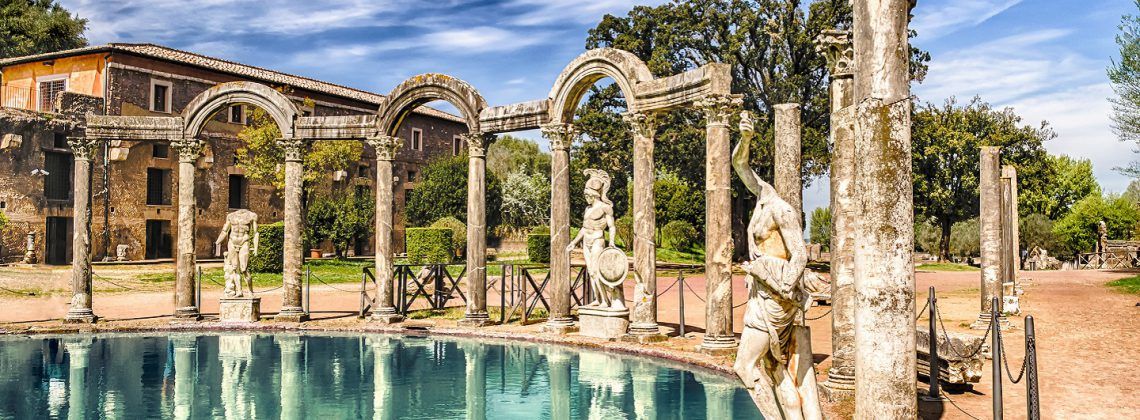The enduring vestiges of the Roman Empire remain with us even today. You can find some of the most important Roman structures across much of Eurasia and in the northern countries of Africa. Follow along as I share my favorite, iconic structures like Hadrian’s Wall, Segovia’s aqueduct, the ruins at Jerash, the Herodium, the Colosseum, and so much more.
Greatest Roman Architecture Still Standing Today
Ancient Rome built one of the widest-reaching empires, which extended across the majority of European territories. The Roman Empire included the Mediterranean Sea as a central axis, connecting the farthest corners of Eurasia and Africa via this waterway.
Over centuries, Roman emperors left the imprints of their power and wealth, bringing Rome’s identity to whichever territory they had conquered by building monumental structures and cities. In this article, I will take you on a journey across this ancient empire, exploring 30 of the most impressive Roman sites and structures still standing today.
30. Hadrian’s Wall
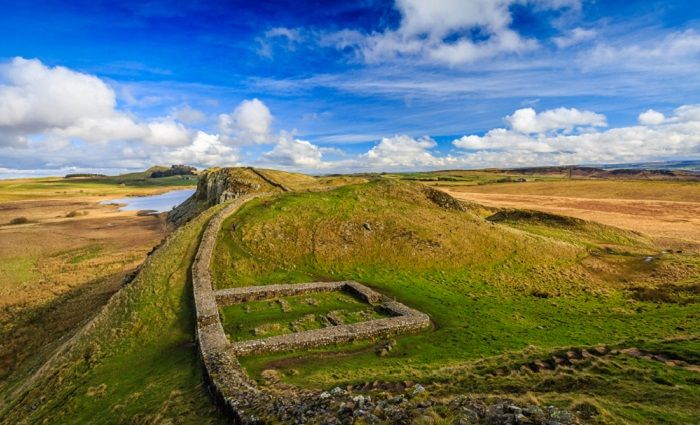
England | Vindolanda | Picts
Hadrian’s Wall (Vallum Hadriani in Latin) symbolized the frontier of the Roman Empire in Britannia. This magnificent wall stood tall to protect the territories of Rome from the Picts. This 178-kilometer wall crossed the island from the current Wallsend (Northumbria) to Bowness-on-Solway (Northwest Cumbria).
The construction of this wall began during Hadrian’s reign, around 122 AD and took about six years to complete. Along this monument, you can find different structures such as towers and forts which flanked the wall at a regular intervals.
Eventually, nearby military bases developed into small villages, such as the well-known Vindolanda. If you want to experience what it was like to live on the northern edge of the empire, Vindolanda’s well-preserved remains and objects will leave a lasting impression.
29. Roman Bath

England | Bath | Celts
The Roman baths from Bath (Somerset, England) are one of the best examples of this kind in northern Europe. Coincidentally, the Celt’s beliefs in the goddess Sulis developed around the natural springs located here.
After their arrival, the Romans integrated this deity into their religious beliefs. In addition, they built a temple here during AD 60-70. As a result, over the next decades, an urban settlement developed around the religious complex to accommodate the growing community, at the same time that the Romans erected a bath complex.
Visiting Bath and this monument even on a cold, windy day will help you reflect on nature’s importance in antiquity!
28. Maison-Carrée
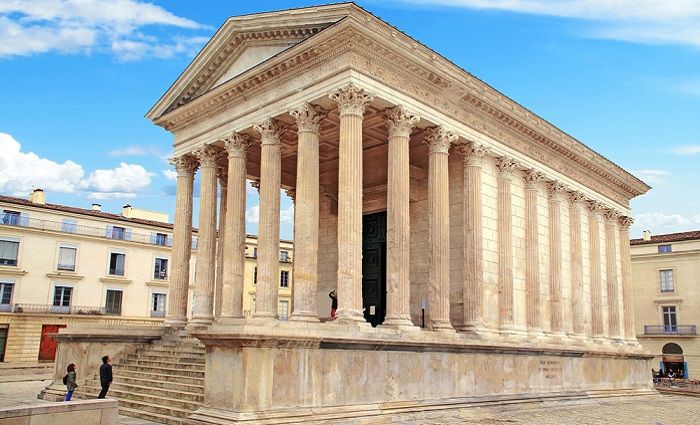
France | Nîmes | Temple
Nîmes, France, houses one of the best preserved temples from the Roman world. The structure, which is today known as Maison-Carrée (The Square House), dates to the end of Augustus’ reign, circa 5 BC. Furthermore, an inscription indicates a dedication to Lucius and Gaius Caesar, Augustus’ grandsons.
Archaeologist Jeffrey Becker affirms this temple is worth visiting because it is an example of Vitruvian architecture. That’s a fancy way of saying it totally fits the canonic descriptions of ancient architecture with the podium foundation and colonnades. Furthermore, its state of preservation and its Corinthian decoration make it a unique example of Roman architecture.
27. Pont du Gard
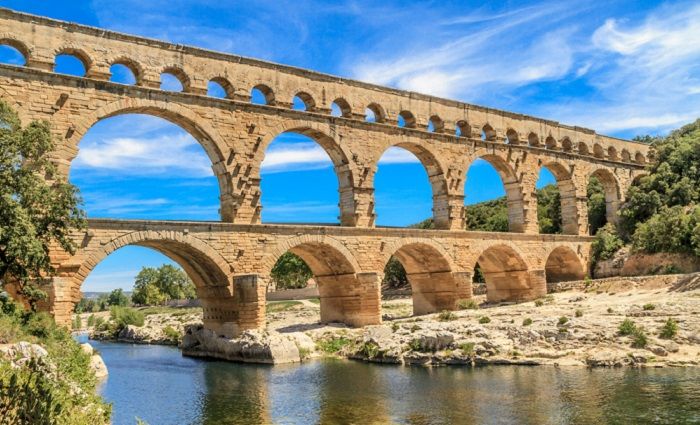
France | Bridge | Aqueduct
Pont du Gard is one of the most impressive aqueduct bridges of the Roman world. The empire likely built it at the end of the first century B.C. However, some scholars argue for a mid-first century A.D. date for its construction and the debate still rages at present.
This aqueduct stands 49 meters high and runs 275 meters long at the longest point of the three levels. The lower portion serves as a bridge over six, wide arches over the river Gardon. The middle portion sustains the aqueduct over its 11 arches. The upper part contains the aqueduct that directed water into the city of Nîmes over the 35 small arches.
One of the most impressive facts is that the Romans didn’t use concrete to join the stone blocks! In fact, you can still see the stonemason’s marks designating pieces for precise fitting. I recommend visiting this spot and taking some pictures of this magnificent bridge that fits so serenely into the natural landscape.
26. Nîmes Arena
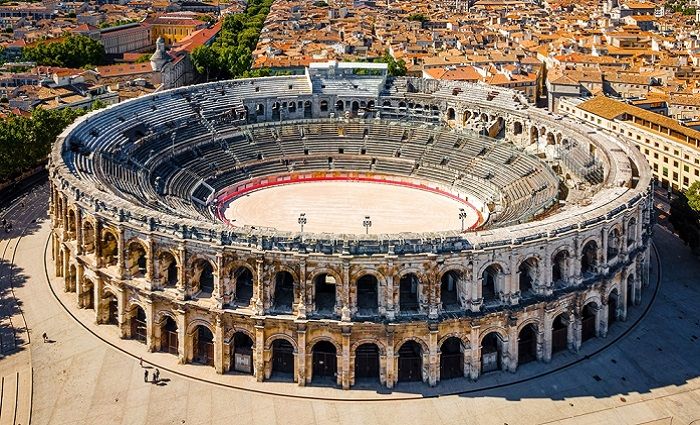
France | Nîmes | Amphitheatre
The Arena of Nîmes is one of the best preserved amphitheaters left standing from the Roman Empire, compared to its more famous cousin, the Colosseum in Rome. In fact, it’s so intact that it’s used even today for bullfights during the Féria, according to the Avignon and Province website.
This monument dates to the end of the first century A.D. and has an elliptical shape of 133 by 101 meters. It’s a familiar shape and design to the Rome Colosseum, so the arches on the exterior façade support up to 23,000 spectators inside.
In the Middle Ages, the Visigoths repurposed the fortress to house churches, wells, and even houses. Finally, at the end of the 18th century, restorations started to unveil the original form of the amphitheater you can visit today.
You can visit this place to learn more about history, attend a music event, or do other activities the city of Nîmes organizes periodically.
25. Theatre of Orange
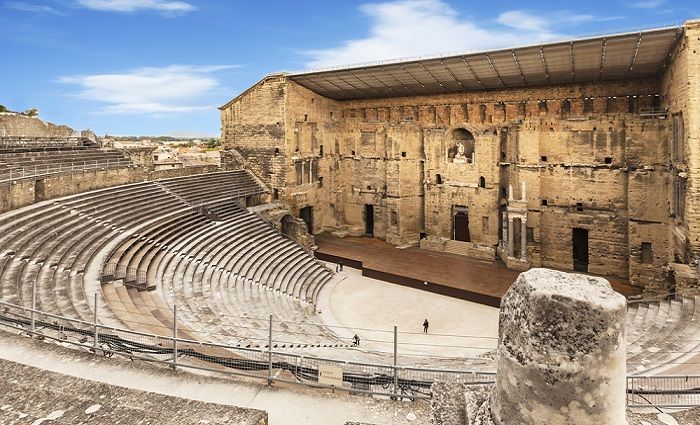
France | Vaucluse | Augustus
You’ll find the most well-preserved theatre built during Augustus’ reign in Orange, France. It’s called the Theatre of Orange or Théâtre Antique d’Orange. The Romans erected this structure on a hillside, yet it’s still in an excellent state of preservation. For instance, the grandstand, passageways, and corridors remain nearly unchanged, despite their massive size on a hillside that could have eroded over time.
In addition, one of the most impressive parts of the theatre is the façade. It measures 102 meters long and 38 meters high—a commanding presence. Corbels and arched entries are visible and the amphitheater seating inside still remains rather intact. Nowadays, you can also observe the elegant sculpture of emperor Augustus welcoming visitors.
24. The Aqueduct of Segovia
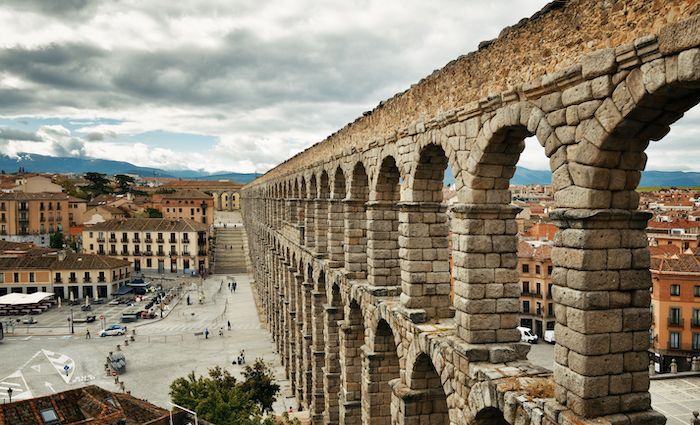
Spain | Segovia | Aqueduct
The fully preserved Roman aqueduct from the city of Segovia will thrill anyone. Historians Santiago Martínez and Víctor Caballero note that the Romans erected the monument during in the first decades of the second century A.D. This moment of history coincides broadly with the end of Trajan’s reign and the beginning of Hadrian’s reign.
The impressive structure has 165 arches organized on two levels. In total, the aqueduct is 728 meters long on its upper side and reaches about 28 meters. This aqueduct is another engineering masterpiece that did not use any mortar during construction.
During the Middle Ages, the aqueduct became an insignia of the flourishing city. In addition, in 1520, Segovians placed one sculpture of the Virgin Mary with Jesus and one of St. Sebastian in the central niches to protect the city.
Love this content? Dive into our other popular topics like accomplished Roman emperors, things you must see in Spain, or a brief history of Rome.
23. Augusta Emerita
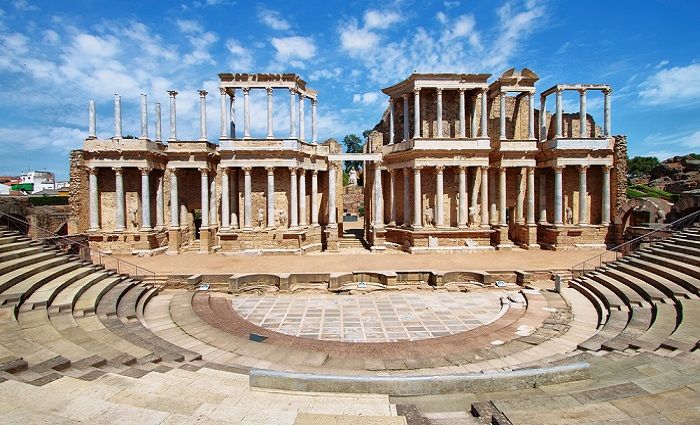
Spain | Extremadura | Mérida
The city of Mérida, in the province of Badajoz, was one of the most important cities in the Roman province of Hispania. Initially, the Romans founded the city in 25 B.C. as Augusta Emerita, the capital of the Lusitania province. Afterward, it became the capital of the whole Iberian Peninsula (Diocesis Hispaniarum) at the end of the third century A.D.
Mérida is worth visiting because it offers a complete experience of Roman-era Spain and its art. For instance, the city has a well-preserved theatre, amphitheater, aqueducts, temples, and numerous houses. Getting lost in the National Museum of Roman Art should be at the top of your list here!
22. Roman Bridge at Alcántara
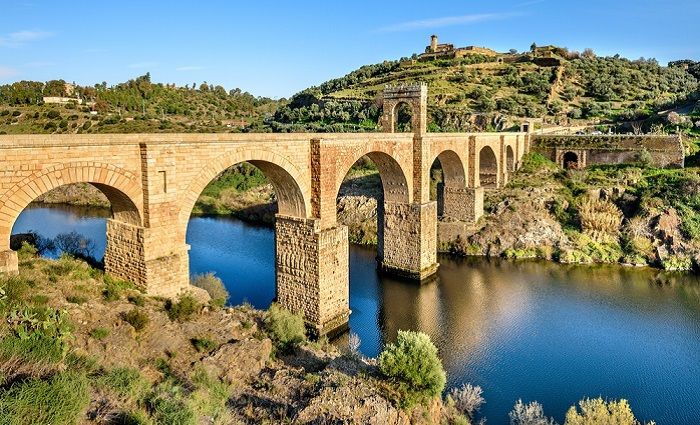
Spain | Extremadura | Portugal
The Roman bridge at Alcántara, in the province of Cáceres, holds its own as another ideal example of Roman bridges still standing today. This bridge helped connect and defend the crucial route between Spain and Portugal.
The bridge (built under Trajan’s reign around 105-106 A.D.), stands over the Tagus River, with six monumental arches and a triumphal arch. What you can see now is the result of multiple restorations carried out over centuries.
Stop by the nearby temple and read the inscription that mentions the architect of this masterpiece: Gaius Julius Lacer.
21. Volubilis
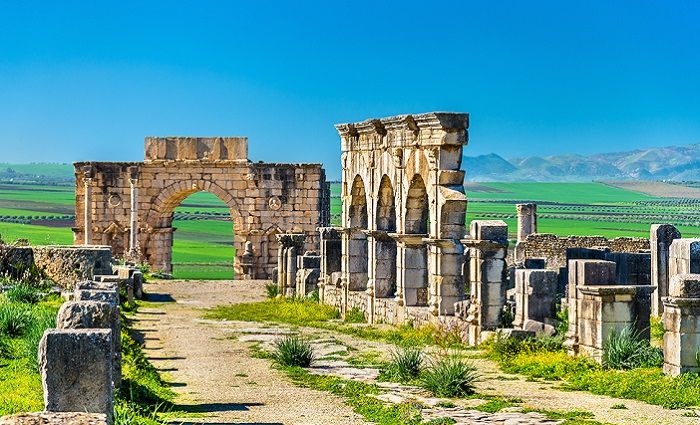
Morocco | Fès | Jebel Zerhoun
Volubilis is one of the most iconic archaeological sites of Morocco, located near the city Meknes. Before the arrival of the Romans, this city was the capital of the Kingdom of Mauretania. Moreover, it acquired regional importance under the reign of Juba II as he helped the city’s trade flourish with goods like timber and Tyrian purple.
Eventually, the Roman Empire annexed the city in circa AD 44. As a result, Volubilis experienced new urban projects like the construction of temples, baths, and a basilica. These changes also brought about new socio-cultural shifts with elite, luxury mansions paved with exquisite mosaics. These are now the main attraction of the city!
The Diocletian reign eventually abandoned Volubilis, but its rediscovery began in the 19th century. I recommend visiting this city if you want to travel back in time almost 2,000 years and walk endless avenues and streets!
20. Thamugadi
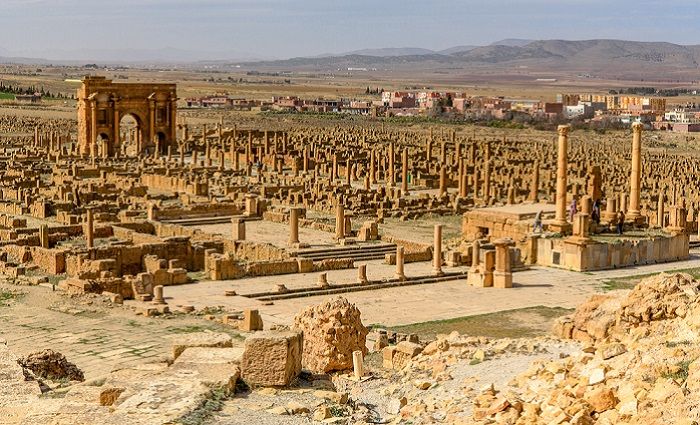
Algeria | North Africa | Timgad
Ancient Thamugadi (currently known as Timgad) is famous for its regular urban grid ruins, which always impresses visitors. Founded by Trajan in approximately 100 A.D., the city sits in the North African province of Numidia. A century after its foundation, this place became an important regional center that housed around 15,000 habitants.
Over time, Thamugadi became an urban oasis whose economic growth relied on grain export. As a consequence, impressive urban developments began, including mansions, baths, temples, churches, and even a library. If you want to experience urban life in Roman North Africa, this is another perfect place to wander hundreds of streets!
19. Bulla Regia
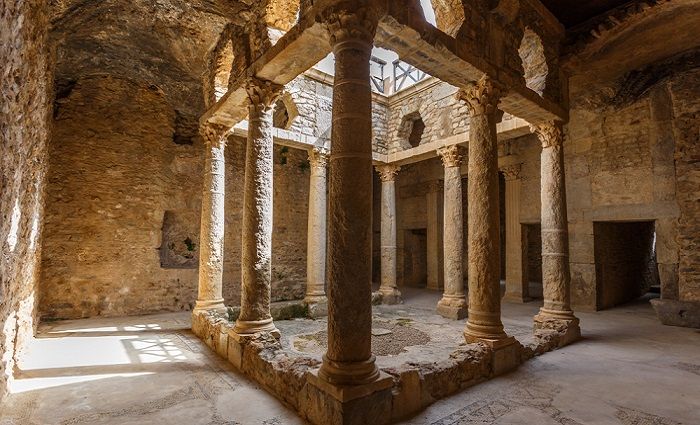
Tunisia | Jendouba | Mosaics
Bulla Regia is a Roman city located about 8 kilometers north of the current city of Jendouba in Tunisia. This partially excavated city began after Julius Caesar’s victories in the region around 46 B.C. Archaeologists describe Bulla as “the city of the subterranean mansions” because its elite built subterranean complexes and richly decorated them.
Archaeologist Raquel Rubio notes how these mosaics show the sociocultural preferences of wealthy people in Roman North Africa. From hunting activities to gods and dining parties, the iconography of these mosaics will leave you speechless.
18. The Amphitheatre of El Jem
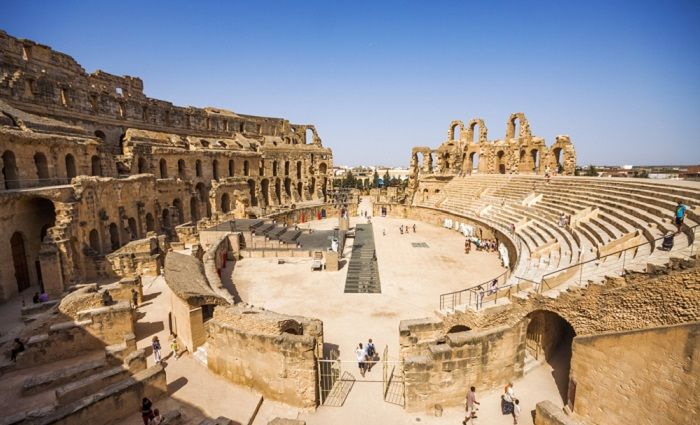
Tunisia | El Djem | Amphitheater
El Djem (anciently known as Thysdrus) houses one of the most impressive amphitheaters in Roman North Africa. The city entered the Roman sphere after 46 B.C., although it was not until 244 A.D. that it became a colony.
This amphitheater had an estimated capacity of 35,000 spectators inside its oval shape which measures 148 by 122 meters. These numbers exemplify the importance of the city in the third century A.D. when construction likely occurred. In the Middle Ages, the amphitheater became a fortress—a fact that allowed the preservation of part of the structures as we see them nowadays.
17. Leptis Magna
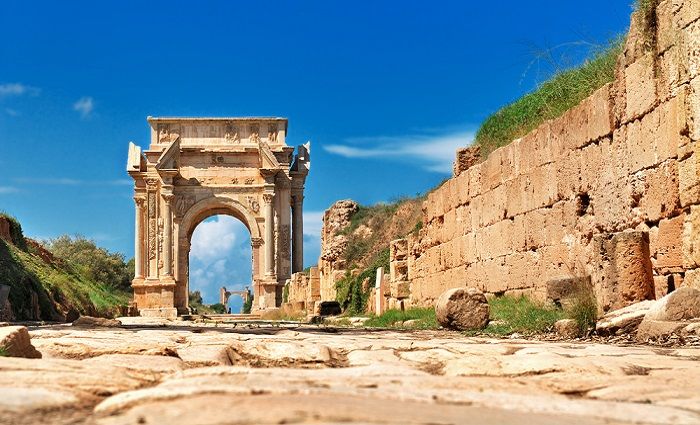
Libya | Tripoli | Homs
Leptis Magna is one of the most impressive Roman outposts in North Africa. This Libyan city located near the current city of Homs, was Phoenician, Carthaginian, and Numidian before falling into the hands of Rome.
Due to this rich cultural substratum, the site maintained its local traditions during the first century A.D. It was in the second century A.D. when the Roman presence grew intense. For instance, under Septimius Severus’ reign (193-211 A.D.), the city underwent numerous building programs.
Under his reign, Leptis Magana became one of the most important centers in North Africa in this period. As a result, colonnaded streets, monumental arches, and public baths were added to this city, which also redeveloped the harbor and increased its Mediterranean trade.
16. Diocletian’s Palace
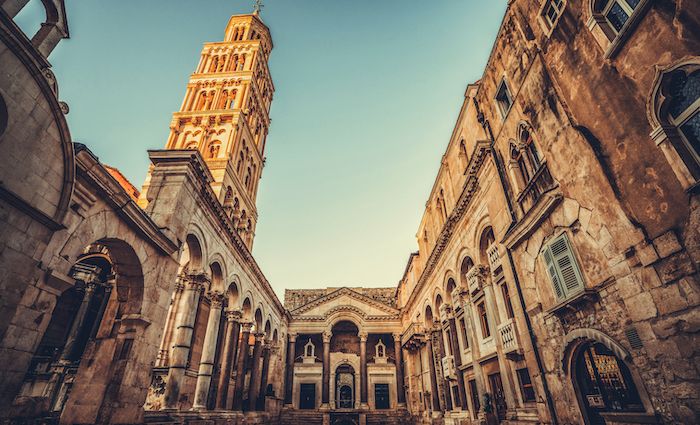
Croatia | Split | Diocletian
Split, Croatia, houses the largest palace with almost original integrity from the Roman era. Emperor Diocletian built the complex between 295 and 305 A.D. as a place to retirement. The palace actually still stands as part of Split’s city center.
The original function intended to protect the city as a sea fortress with towers, sumptuous saloons, and courtyards. Some of its structures were updated into a cathedral, baptistery, and other modern buildings. Art historians consider this palace an excellent example of both Greek and Byzantine artistic styles.
15. Porta Nigra
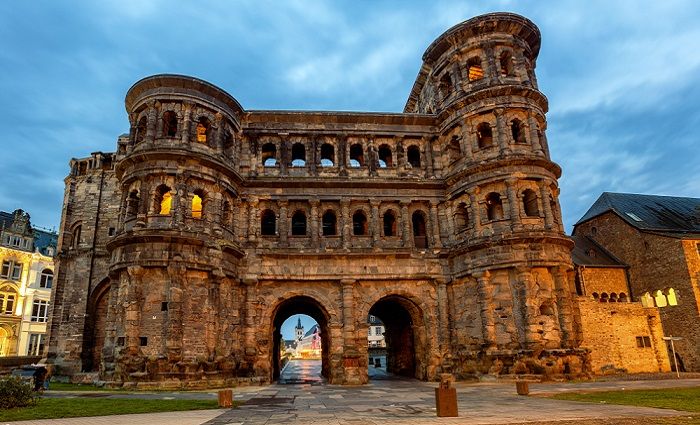
Germany | Trier | City Gate
If you visit Trier in Germany, you will observe numerous archaeological remains from the ancient city of Augusta Treverorum. One of the main gates accessing the city stands out from among all the ruins and has impressed travelers for centuries. In fact, you can climb the steps for the famous Porta Nigra for an impressive view of the city and an up-close look at the marvelous engineering.
The name of this gate originated in the Middle Ages due to the dark color of the stone. Recently, archaeologists accurately dated the construction of the structure in 170 A.D., as noted by Mechthild Neyses-Eiden. Of all the remaining gates from the Roman Empire north of the Alps, this is one of the most well-preserved.
Wish you could see some of these amazing structures? We offer tours to many Roman ruins in Spain, Italy, and more.
14. Market Gate of Miletus
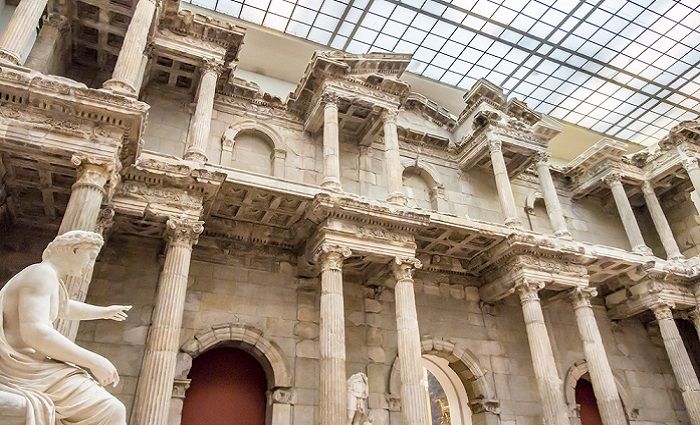
Turkey | Berlin | Museum
Likely under Hadrian’s reign, this beautiful marble monument is now one of the most impressive gates of the Roman world. Though it was built in Miletus, Turkey, it’s now displayed at the Pergamon Museum of Berlin, probably because the monument was excavated by Theodor Wiegand starting in 1903.
After it arrived in Berlin, archaeologists reconstructed the original aspect of the gate during a controversial restoration program, as noted by scholar Can Bilsel. Wiegand bent some Turkish laws during that process and the ensuing shipments to Germany. Despite that, its rather impressive structure inside a building will impress just about anyone.
13. Library of Celsus
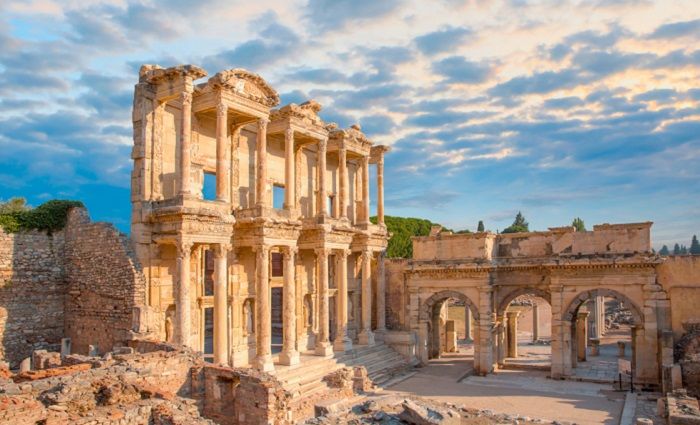
Turkey | Ephesus | Library
The famed Library of Celsus honors the memory of Tiberius Julius Celsus Polemaenus, as mentioned on one of the inscriptions of the façade. Celsus Polemaenus was one of the most important men in the city at the end of the first century A.D., thanks to his role as a senator and proconsul. He advocated for a library in the city, according to author Izabela Miszczak, and some of his legacy continued through his son and other relatives after his death.
Archaeologists found the remains of the monumental façade in the 1910s, and in the 1970s, Volker Michael Strocka led the reconstruction work of the numerous fragments discovered. The monument was a library and a mausoleum that housed a sarcophagus with the remains of Tiberius Julius Celsus Polemaenus in an apsidal underground room. An earthquake or a fire destroyed the building in AD 262, as archaeologists later discovered.
12. Theater of Aspendos
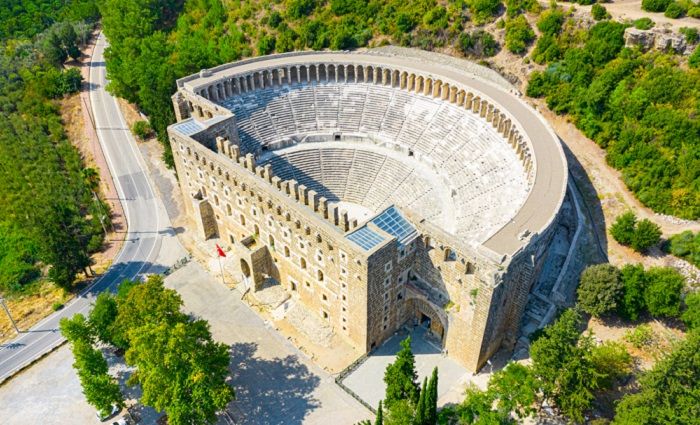
Turkey | Aspendos | Greek Style
You’ll find an incredible Roman theatre in Aspendos. Zeno, a Greek architect from Aspendos, designed the structure with a commission by the brothers C. Crispinus and C. Auspicatus. This is noted in the inscriptions from the building.
Marcus Aurelius’ reign (161-180 A.D.) witnessed the construction of this building which presents a combination of Greek and Roman styles. What most amazes visitors is how the whole building—including the façade and the upper galleries of the grandstand—is almost intact. If you want to have a 360-degree experience of what it was to attend a play in the Roman period, this is the place to visit!
11. Baalbek
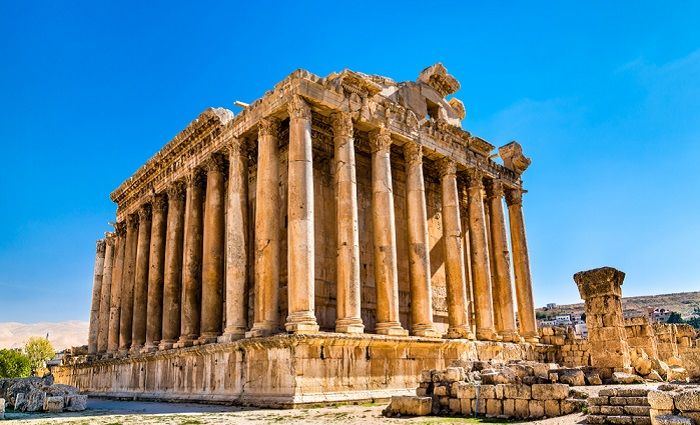
Lebanon | City of the Sun | Temples
Baalbeck, in central Lebanon, is famous for housing the biggest excavated temples ever built in the Roman world. So far, archaeologists have identified the remains of at least three temples.
The first temple, dedicated to Jupiter Heliopolitanus, is the biggest complex in the Empire. Before the temple stood a richly decorated courtyard and a majestic entrance back in the day. Another temple dedicated to Bacchus, can also be explored with similar courtyards and colonnades to view. Finally, the city is home to other remains, such as the circular temple associated with Venus, and other mosaics and structures.
10. Palmyra
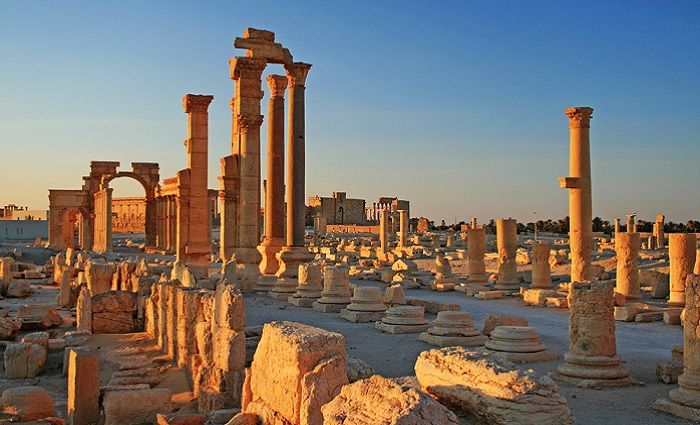
Syria | City of the Sun | Temples
Palmyra, which was also known as Tadmur in antiquity, is the best preserved city in Syria. This urban center became part of the Roman world under Tiberius’ reign and experienced an urbanistic boom over the next two centuries. As a result, the elite of the city built colonnaded avenues, a theatre, temples, and monumentalized fountains and squares.
Archaeologists consider the tombs with the sculptural remains found outside the city as one of the best examples to study the cosmopolitan society of these territories in the Roman period. Unfortunately, some of these monuments have been destroyed by the Islamic State, looting, and terrorism. Nevertheless, these ruins that linked Damascus and the Euphrates are what remains of an important era and are worth a look if you’re in the area.
9. Jerash
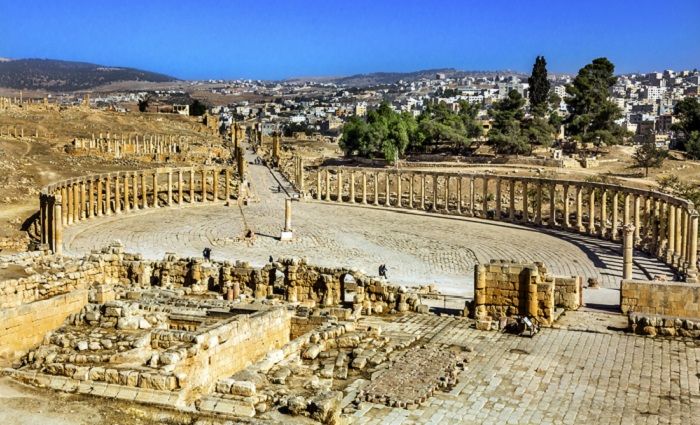
Jordan | Gerasa | Arch of Hadrian
Jerash is a Jordanian city located about 45 kilometers to the northwest of Amman. Under the streets of the current city lie the remains of one of the main urban centers of this region’s ancient past.
This archaeological site is known as “the Pompeii of the East” since the remains have been well preserved. The settlement, which was probably founded by Antioch IV in the second century A.D., experienced an urban boom under the Romans. This was when the city became part of the decapolis (ten cities) that controlled the region back then.
During the second and third centuries, new temples, colonnaded avenues, theatres, and nymphaea were developed, which is why visitors are so impressed today. Moreover, a triumphal arch and a circus were added in an expanding area of the city. After decades of abandonment, a new village originated on the oriental side of the city, under which remains are still buried.
8. Herodium or Herodion
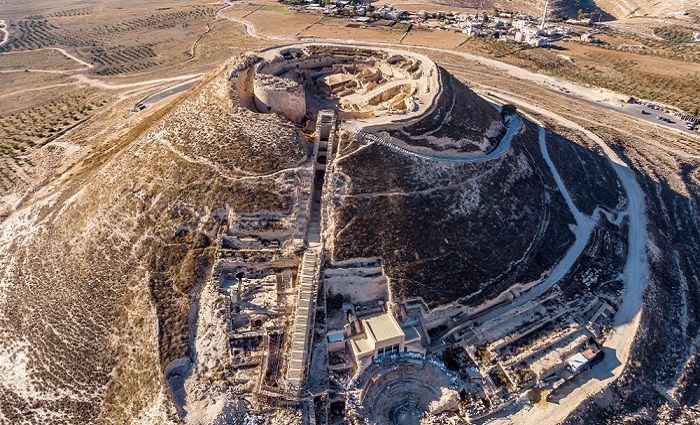
Israel | Herod | Architect
Herodium is the Latin name of the palace complex built by Herod the Great at the end of the first century B.C. outside Jerusalem. This location had great importance for him since his mother passed away there. In addition, it’s where he won a battle against Antigonus the Hasmonean. After becoming King of Judea with the favor of Rome, Herod chose this place from which to rule.
The complex, which was one of the most luxurious palaces of the time, had three parts. First, a circular palace-fortress stood on the top of the hill. The palace had courts, reception rooms, apartments, and circular towers. Second, a theatre, reception rooms, and Herod’s mausoleum were erected on the slopes to the north. Finally, at the bottom of the hill, a lower palace, baths, and other buildings were built.
Here’s just part of why it’s worth a visit: you’ll be impressed at the walkways and staircases to move between the remaining levels of this ancient palace.
7. Masada
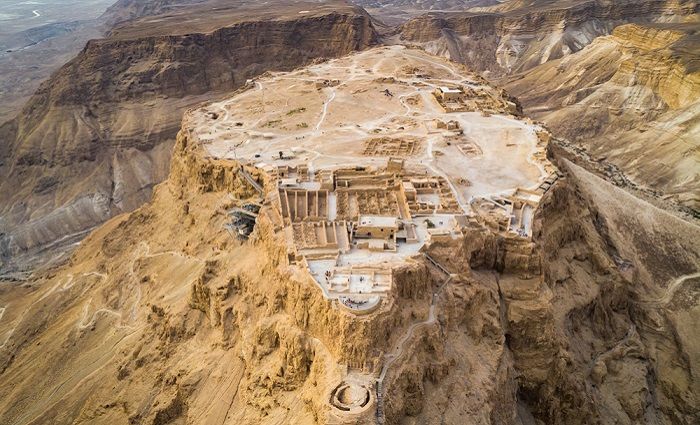
Israel | Siege | Herod
We have always heard about epic military stories from the Roman conquest, and Masada is one of the prime examples. This citadel, built on a hilltop near the Dead Sea, witnessed one of the greatest military challenges of Rome.
After the conquest of Jerusalem in 70 A.D., the last of the Jewish resistance on the hilltop of Masada, refused to surrender. Mainly developed under Herod’s reign, the Masada had different palaces, cisterns, and a settlement for the resistance to survive the conflict. Historian Flavius Josefus explained that it took Rome almost two years and thousands of soldiers to conquer the city. The settlement was almost inaccessible, and only some stairs routes led to the top that were heavily guarded.
During the siege, Romans built military camps and created a vast ramp to access the citadel. After breaking inside, they discovered that the Jewish people had already taken their own lives. Only a few people survived the event, which became a symbol of national resistance in the last century.
6. Villa del Casale
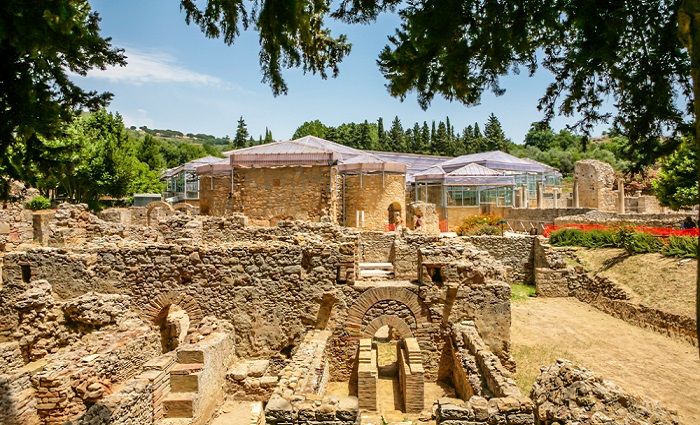
Italy | Sicily | Mosaics
Head to the modern town of Piazza Armerina in Sicily to find a well-preserved Roman villa in the Mediterranean. If you visit this place, you will experience what it was like to live in the countryside as a wealthy Roman at the end of the empire.
For instance, you will walk over thousands and thousands of square meters of mosaics across multiple rooms. From bath to bedrooms, from corridors to reception halls, it’s a stunning place to see how the Roman elites showcased their wealth.
The whole complex even had an aqueduct to provide water continuously to the bath complexes. Also impressive to note are the outside toilets and separate dining rooms for guests.
5. Pompeii
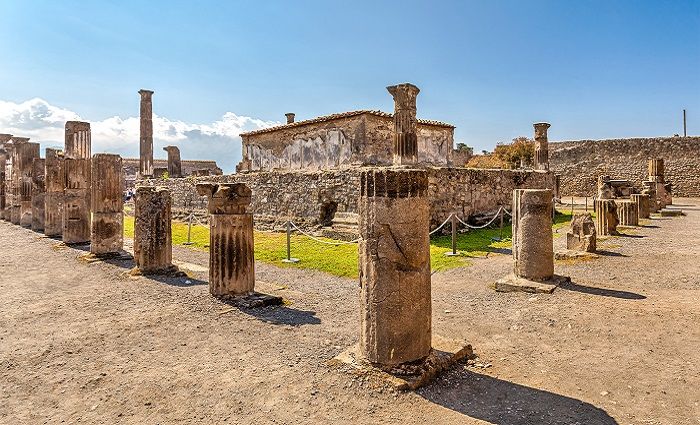
Italy | Naples | Day Trip
Pompeii has always astonished travelers, writers, artists, and anyone else who has wandered its streets. This Roman ghost city (discovered in 1748 and partially excavated) is the best place to understand Roman daily life since the remains are perfectly preserved from a moment in time. Archaeologists are still uncovering the wanders and treasures of this unique city that was destroyed by the eruption of Mount Vesuvius in 79 A.D.
You can visit rich mansions such as the House of Menande, or enter public baths such as the Suburban Baths or Stabian Baths, or discover ancient brothels. Then head to the city market, the theatre, and amphitheater and see what street life was like. One of my favorite things is to stop by the “fast-food street bars” such as the recent one uncovered in Region V or read the remains of political propaganda and imagine myself being a Roman.
4. Hadrian’s Villa
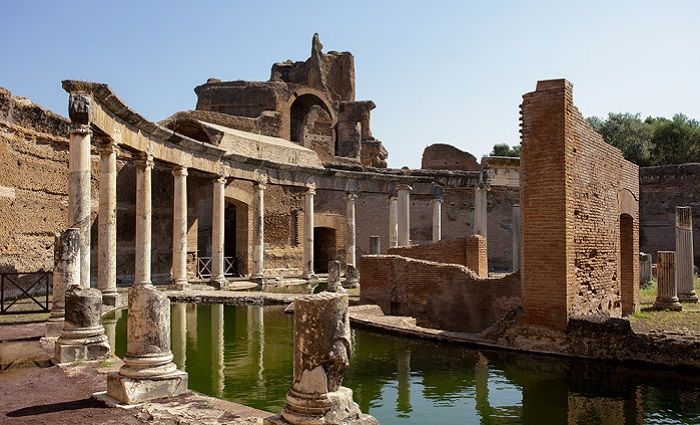
Italy | Rome | Day Trip
Tivoli was the place chosen by emperor Hadrian to build his luxury imperial residence outside the crowded Rome, between 118 and 138 A.D. He spent the majority of his time here when he was not traveling or in the capital.
Since then, archaeologists have uncovered a city-like palace complex, with gardens, libraries, luxury halls, impressive baths, nymphaea and fountains, theatres, and many secrets. For instance, underground passages and rooms guaranteed the movement of slaves and workers for the palace would not mix with the emperor and his guests, as archaeologist Benedetta Adembri notes.
This well-preserved residence will ensure you enjoy a combination of history, archaeology, and nature if you want to disconnect for a day from the crowded Rome and feel like an emperor.
3. Ostia
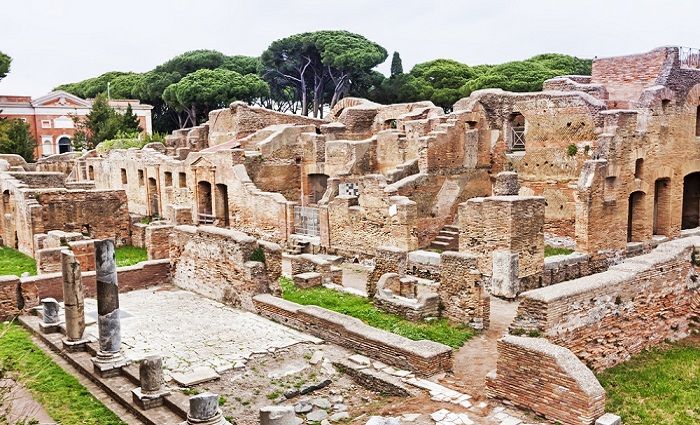
Italy | Rome | Day Trip
Ostia is one of the hidden gems you can discover when visiting Rome, since it is just 30 kilometers from the city center. Anciently, this city was the seaport of Rome which also controlled the access to the River Tiber. The preservation of its buildings makes this place an excellent spot to encounter antiquity in a quick day trip.
Here, you can stop by an ancient street bar, visit a block of apartments, enter a luxury house, or sit by the massive theatre and imagine ancient performances. In addition, you can visit many of the baths built in the city and decorated with rich mosaics. This is the best options I always recommend to experience how it was to live in the suburbs of an empire.
2. Pantheon
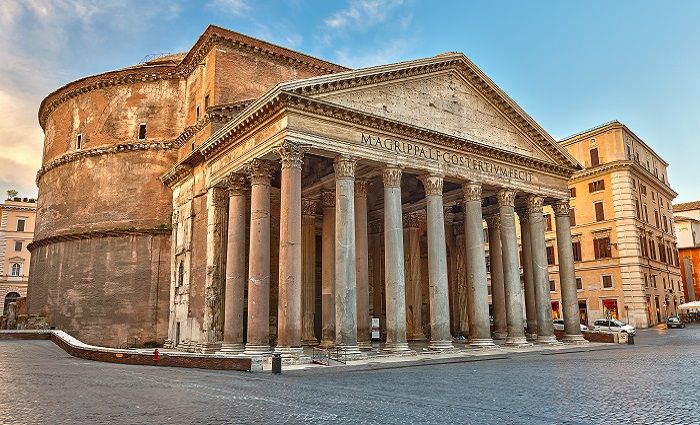
Italy | Rome | Hadrian
The Pantheon is the best structure to understand ancient architecture because of the techniques used in this building. Built during Hadrian’s period over the remains of a previous building, the monument you visit nowadays has remained nearly unchanged over centuries.
Although nowadays the monument is attributed to “all the goods”, its original functionality remains under debate. However, this structure is a unique example of ancient architecture combing Greek and Roman traditions, as archaeologist Filippo Coarelli notes.
The most impressive aspect of this structure is the still-standing dome it houses, made of Roman concrete mixed with different materials. Its good state of preservation is in big part because in 609 it was converted into a church, the Basilica of St. Mary and the Martyrs).
This is the best – and free – option to have a full, immersive experience of ancient architecture, and it is free!
1. Colosseum
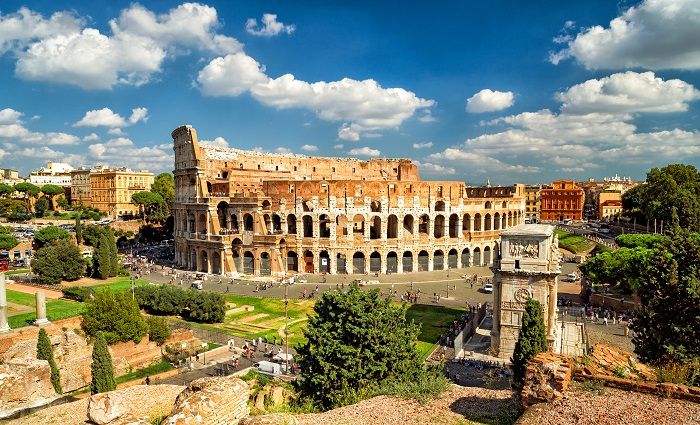
Italy | Rome | Architecture
Rome’s city center houses hundreds of archaeological remains, among which the Amphitheatrum Flavium (Colosseum) stands out. This massive structure came to life under emperor Vespasian around 70-72 A.D. After almost a decade, his son Titus inaugurated it in 80 A.D. with 100 days of games in celebration. Finally, in 82 A.D., Domitian completed the building by adding the upper level.
As archaeologist Amanda Claridge notes, this masterpiece of architecture is a culmination of Roman building techniques. A walk onto the Arena Floor or the upper levels will teach you about the history of the building, Roman architecture and how it was converted into a castle at one point in the Middle Ages. This was partly why half of its monumental façade has remained so well preserved till now.
The most exclusive area to visit is difficult to gain access to: The Underground Tunnels where gladiators and animals waited for their day in the area. In addition, you will learn about the Christian perception of the building and how Popes even tried to build a basilica inside the monument. Are you ready to unlock all the secrets this monument hides?
